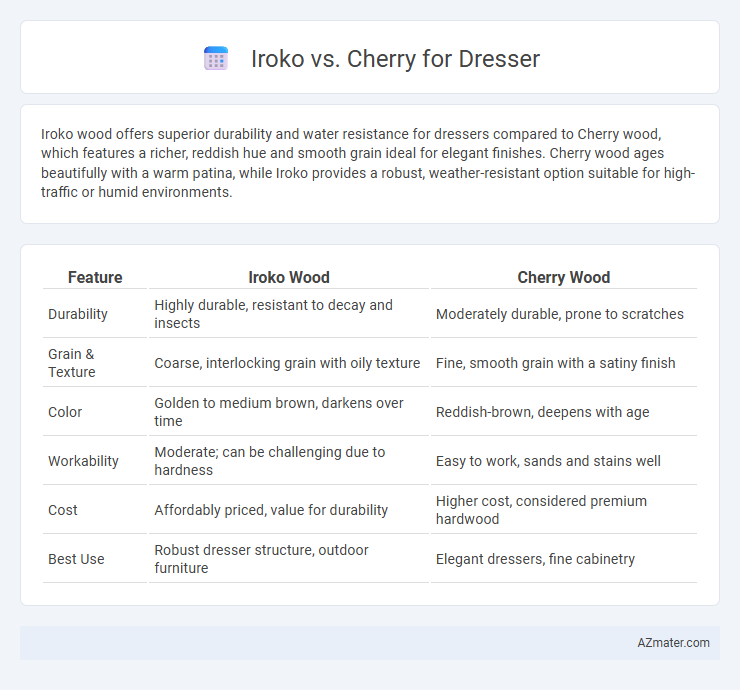Iroko wood offers superior durability and water resistance for dressers compared to Cherry wood, which features a richer, reddish hue and smooth grain ideal for elegant finishes. Cherry wood ages beautifully with a warm patina, while Iroko provides a robust, weather-resistant option suitable for high-traffic or humid environments.
Table of Comparison
| Feature | Iroko Wood | Cherry Wood |
|---|---|---|
| Durability | Highly durable, resistant to decay and insects | Moderately durable, prone to scratches |
| Grain & Texture | Coarse, interlocking grain with oily texture | Fine, smooth grain with a satiny finish |
| Color | Golden to medium brown, darkens over time | Reddish-brown, deepens with age |
| Workability | Moderate; can be challenging due to hardness | Easy to work, sands and stains well |
| Cost | Affordably priced, value for durability | Higher cost, considered premium hardwood |
| Best Use | Robust dresser structure, outdoor furniture | Elegant dressers, fine cabinetry |
Introduction to Iroko and Cherry Wood
Iroko wood, sourced from West Africa, is prized for its durability, golden to medium brown hue, and natural resistance to decay, making it an excellent choice for dressers that require longevity and a rich appearance. Cherry wood, native to North America, features a fine, straight grain with a warm reddish-brown color that deepens with age, offering a classic and elegant look popular in fine furniture. Both woods provide unique aesthetic and practical qualities, with Iroko favoring robustness and Cherry emphasizing timeless beauty.
Appearance and Aesthetic Differences
Iroko wood features a rich golden to medium brown hue with a coarse grain and occasional dark streaks, creating a bold, tropical aesthetic for dressers that complements modern and rustic styles. Cherry wood offers a warm, reddish-brown color that deepens and develops a rich patina over time, providing a smooth, fine-grained, and elegant appearance that enhances traditional and classic dresser designs. Choosing between Iroko and Cherry depends on the desired visual impact: Iroko emphasizes a striking, textured look, while Cherry delivers a more refined and timeless elegance.
Durability and Longevity Comparison
Iroko wood offers exceptional durability and resistance to wear, making it ideal for dressers subjected to frequent use and heavy loads. Cherry wood provides moderate durability with a smooth finish but is more prone to dents and scratches over time compared to Iroko. When longevity is prioritized, Iroko's natural oils and density ensure a longer lifespan and superior resistance to moisture and decay, outperforming cherry in long-term furniture applications.
Workability and Ease of Crafting
Iroko wood offers excellent workability with its medium to coarse grain and moderate density, making it easier to machine and shape for dressers compared to Cherry, which has a finer, closed grain but can be prone to burn marks during cutting. Cherry wood is prized for its smooth sanding and natural polish, allowing craftsmen to achieve a high-quality finish with less effort, while Iroko requires extra care to avoid splintering during detailed carving. Both woods are durable, but Cherry's consistent texture and ease of staining make it preferable for intricate dresser designs demanding fine craftsmanship.
Maintenance and Care Requirements
Iroko wood offers exceptional resistance to moisture and pests, making it low-maintenance and ideal for dressers in humid environments. Cherry wood requires more care, including regular polishing to maintain its rich color and prevent surface scratches, as it is softer and more prone to wear. Both woods benefit from dusting and cleaning with a damp cloth, but Iroko's natural durability reduces the frequency of treatments compared to Cherry.
Cost and Availability Analysis
Iroko wood offers a cost-effective alternative to cherry, typically priced lower due to its widespread availability in West African markets, making it a budget-friendly choice for dresser construction. Cherry wood, prized for its rich color and fine grain, commands higher prices because of limited supply and slower growth rates in North America and Europe. Availability of Iroko is more consistent year-round, whereas cherry can face seasonal shortages, impacting overall project timelines and budgeting.
Environmental Impact and Sustainability
Iroko wood, sourced primarily from West Africa, is known for its durability and resistance to pests, but concerns about deforestation and illegal logging challenge its sustainability credentials. Cherry wood, typically harvested from North American hardwood forests, often comes from managed and certified sources, contributing to more sustainable forestry practices. Choosing cherry for dressers supports responsible forest management, while iroko's environmental impact varies significantly based on sourcing and certification.
Suitability for Dressers: Strength and Functionality
Iroko wood offers exceptional strength and durability, making it highly suitable for dressers that require long-lasting structural integrity and resistance to wear. Cherry wood provides a smoother texture and rich, warm tones, enhancing the dresser's aesthetic appeal while maintaining moderate hardness for everyday use. Iroko's natural resistance to moisture and decay gives it a functional advantage in preventing damage in humid environments compared to cherry.
Style and Design Versatility
Iroko wood offers a rich golden to medium brown hue with distinct grain patterns, lending dressers a warm, natural aesthetic that complements rustic and traditional interiors. Cherry wood features a smooth, fine grain and a deep reddish-brown color that ages gracefully to a rich patina, enhancing the elegance of modern and classic designs. Both woods provide excellent design versatility, with Iroko suited for bold, earthy styles and Cherry ideal for refined, sophisticated furniture pieces.
Final Verdict: Best Choice for Dressers
Iroko wood offers exceptional durability and a rich golden-brown hue that deepens over time, making it ideal for dressers requiring long-lasting strength and a warm aesthetic. Cherry wood provides a smooth texture and elegant reddish tone that gracefully ages to a deep, rich patina, perfect for classic and sophisticated dresser designs. For dressers emphasizing resilience and a bold look, Iroko stands out, while Cherry suits those seeking timeless beauty and refined craftsmanship.

Infographic: Iroko vs Cherry for Dresser
 azmater.com
azmater.com